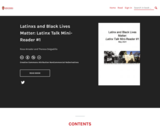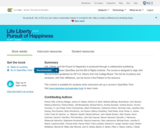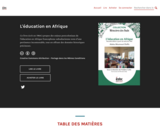
Word Count: 6468
(Note: This resource's metadata has been created automatically by reformatting and/or combining the information that the author initially provided as part of a bulk import process.)


Word Count: 6468
(Note: This resource's metadata has been created automatically by reformatting and/or combining the information that the author initially provided as part of a bulk import process.)

This seminar explores “land” as a genre, theme, and medium of art and architecture of the last five decades. Focusing largely on work within the boundaries of the United States, the course seeks to understand how the use of land in art and architecture is bound into complicated entanglements of property and power, the inheritances of non-U.S. traditions, and the violence of colonial ambitions. The term “landscape” is variously deployed in the service of a range of political and philosophical positions.

Are you using this textbook in your class? Let me know!

Word Count: 14985
(Note: This resource's metadata has been created automatically by reformatting and/or combining the information that the author initially provided as part of a bulk import process.)

Word Count: 25128
(Note: This resource's metadata has been created automatically by reformatting and/or combining the information that the author initially provided as part of a bulk import process.)

As events of the last few years have shown, the Supreme Court has played a crucial role in American political life. There is practically no issue of social significance in the American past that did not at some point end up in the nation’s courtrooms, yet much of the workings of the constitution remain obscure. This subject is designed to introduce students to the main themes and events of American constitutional law since 1787. It introduces terms and concepts of law and legal history, focusing on three recurring themes in American public life: liberty, equality, and property. Readings consist mostly of original court cases, especially from the U.S. Supreme Court, but the focus of the class is on the historical connections between those cases and broader social, political, and cultural trends.

Un demi-siècle au service de l'enseignement supérieur et de la recherche en Afrique
Long Description:
Le Conseil africain et malgache pour l’enseignement supérieur (CAMES), fondé à Niamey en 1968, est une institution panafricaine au cœur de l’histoire intellectuelle et scientifique de l’Afrique francophone moderne. À l’occasion de son cinquantenaire, l’historien Chikouna Cissé fait le point sur l’ensemble des faits et des humains qui ont fait de cette institution celle qu’elle est devenue en 2018, de la volonté initiale des chefs d’État de l’OCAM à son Plan stratégique de développement 2015-2019. Cette histoire part à la recherche des traces matérielles, des solidarités originelles et des stratifications générationnelles qui ont permis au CAMES d’advenir, de surmonter obstacles et erreurs et d’avancer vers la modernité. Elle convoque de nombreux angles d’analyse issus du droit, de l’économie, de la philosophie des sciences et de la sociologie. Comment le CAMES a-t-il produit sa légitimité juridique et scientifique dans un contexte décolonial? Comment cette institution a-t-elle été financée? Quelle place son système d’évaluation occupe-t-il dans les politiques universitaires des pays membres? Qu’a fait le CAMES pour encourager la recherche africaine? Utilisant autant l’analyse des documents que l’histoire orale, ce livre permettra à toute l’Afrique de s’approprier l’histoire d’une de ses institutions les plus remarquables.
Word Count: 82594
ISBN: 978-2-924661-56-7
(Note: This resource's metadata has been created automatically by reformatting and/or combining the information that the author initially provided as part of a bulk import process.)

This class explores the creation (and creativity) of the modern scientific and cultural world through study of western Europe in the 17th century, the age of Descartes and Newton, Shakespeare, Milton and Ford. It compares period thinking to present-day debates about the scientific method, art, religion, and society. This team-taught, interdisciplinary subject draws on a wide range of literary, dramatic, historical, and scientific texts and images, and involves theatrical experimentation as well as reading, writing, researching and conversing.
The primary theme of the class is to explore how England in the mid-seventeenth century became “a world turned upside down” by the new ideas and upheavals in religion, politics, and philosophy, ideas that would shape our modern world. Paying special attention to the “theatricality” of the new models and perspectives afforded by scientific experimentation, the class will read plays by Shakespeare, Tate, Brecht, Ford, Churchill, and Kushner, as well as primary and secondary texts from a wide range of disciplines. Students will also compose and perform in scenes based on that material.

Short Description:
Histoire de la bibliothèque numérique Les Classiques des sciences sociales et réflexions sur son avenir
Long Description:
La bibliothèque numérique francophone Les Classiques des sciences sociales fête ses 25 ans en 2018. Que s’est-il passé au cours de ces 25 années? Comment la bibliothèque s’est-elle construite? Quels sont les choix qui s’offrent à elle actuellement et pour l’avenir? Cet ouvrage collectif a un premier but : raconter, au fil de plusieurs récits et témoignages, la vie autour de ce projet exceptionnel, les motivations et idéaux derrière sa création, les hommes et les femmes impliqués à différentes périodes, son immense impact dans la francophonie. Il constitue aussi un hommage au fondateur des Classiques, Jean-Marie Tremblay, ainsi qu’à toutes les personnes qui ont œuvré au développement de cette bibliothèque numérique, en particulier l’équipe internationale de bénévoles.
Cet ouvrage collectif propose également plusieurs chapitres qui visent à réfléchir aux notions, questions et pratiques au cœur du projet des Classiques des sciences sociales, ainsi qu’aux enjeux contemporains des bibliothèques numériques : l’accès libre aux publications scientifiques, la gestion des données, la numérisation et la préservation du patrimoine scientifique, la justice sociale, les communs numériques, la justice cognitive et le patrimoine numérique. Ces contributions, par leur diversité et leur qualité, enrichissent la réflexion sur l’avenir des Classiques des sciences sociales, mettent en lumière des possibilités inexplorées et permettent de faire des liens avec d’autres initiatives et projets similaires.
Word Count: 96009
ISBN: 978-2-924661-51-2
(Note: This resource's metadata has been created automatically by reformatting and/or combining the information that the author initially provided as part of a bulk import process.)

October 1915–April 1918
Word Count: 41743
(Note: This resource's metadata has been created automatically by reformatting and/or combining the information that the author initially provided as part of a bulk import process.)

This course explores the history of the ideal of personal freedom with an eye towards contemporary debates over the pros and cons of the regulatory state. The first part of the course surveys the sociological and theological sources of the concepts of freedom and civil society, and introduces liberty’s leading relatives or competitors: property, equality, community, and republicanism. The second part consists of a series of case studies in the rise of modern liberty and libertarianism: the abolition of slavery, the struggle for religious freedom, and the twentieth-century American civil liberties movement. In the last part of the course, we take up debates over the role of libertarianism vs. the regulatory state in a variety of contexts: counter-terrorism, health care, the financial markets, and the Internet.

Life, Liberty, and the Pursuit of Happiness is produced through a collaborative publishing agreement between OpenStax and the Bill of Rights Institute. The course is designed to align with the curriculum guidelines for AP U.S. History from the College Board. This content is available for students when instructors set up a course in OpenStax Tutor. Visit www.openstax.org/openstax-tutor to learn more.

Short Description:
Whether it is called living, cultural, or intangible, the practices that make up our heritage are at the centre of community and social life. This publication presents twelves projects of living heritage safeguarding and promotion that have recently taken place in Saskatchewan. Each presentation is based on an interview with those who led the project and stands as an example of the kind of work cultural, heritage, and folklore workers and researchers have in mind when they speak of cultural, living, or intangible heritage. As a whole, this online resource also serves to highlight the vitality of heritage work and research in Saskatchewan, as well as the diversity of communities and organizations doing heritage work in the province.
Long Description:
Whether it is called living, cultural, or intangible, the practices that make up our heritage are at the centre of community and social life. This publication presents twelves projects of living heritage safeguarding and promotion that have recently taken place in Saskatchewan. Each presentation is based on an interview with those who led the project and stands as an example of the kind of work cultural, heritage, and folklore workers and researchers have in mind when they speak of cultural, living, or intangible heritage. As a whole, this online resource also serves to highlight the vitality of heritage work and research in Saskatchewan, as well as the diversity of communities and organizations doing heritage work in the province.
Word Count: 7937
(Note: This resource's metadata has been created automatically by reformatting and/or combining the information that the author initially provided as part of a bulk import process.)

Short Description:
Ce livre écrit en 1964 à propos des enjeux postcoloniaux de l’éducation en Afrique francophone subsaharienne reste d’une pertinence incontestable, tout en offrant des données historiques précieuses.
Long Description:
« Si […] on ne perd pas de vue l’importance du facteur culturel et humain pour toute tentative de sortir du sous-développement, pour sauvegarder effectivement l’originalité africaine, la personnalité africaine dans leurs aspects les plus authentiques et les plus positifs, on comprendra l’importance qu’il faut accorder aux questions d’enseignement et d’éducation, l’urgence de leur étude approfondie et de la discussion des voies déjà proposées ou expérimentées, le caractère impératif de l’élaboration de solutions adaptées aux conditions, mais aussi aux objectifs immédiats et lointains de l’ensemble des peuples d’Afrique Noire, aux exigences de la libération totale de l’homme Noir Africain, et à l’éclosion et l’épanouissement de son génie. »
Ce livre écrit en 1964 à propos des enjeux postcoloniaux de l’éducation en Afrique francophone subsaharienne reste d’une pertinence incontestable, tout en offrant des données historiques précieuses. Cette réédition, sous la direction de Frédéric Caille, servira aux étudiants et étudiantes, chercheuses et chercheurs et à toutes les personnes qui continuent à réfléchir à la meilleure manière de garantir un accès universel à l’éducation en Afrique.
Word Count: 126554
ISBN: 978-2-924661-77-2
(Note: This resource's metadata has been created automatically by reformatting and/or combining the information that the author initially provided as part of a bulk import process.)

Short Description:
MEDIAUCRACY: Why Canada hasn't made global hits and how it can is the story of the fiery collision between Canada's national TV policy and the global, online era. Featuring interviews with Hollywood showrunners, award-winning producers, and top policy leaders, it argues for a new goal -- globality -- policy that incentivizes global reach and popular content. Mediaucracy concludes with an original five-step, goal-driven, evidence-based, critical path including POM to COM, G-Score, and PM to AM. Called an "important, timely roadmap to a much-needed policy update," this 21st century tool kit will future-proof Canadian TV policy via the three key words in the TV biz: Audience, audience, audience.
Long Description:
MEDIAUCRACY: Why Canada hasn’t made global hits and how it can is the untold the story of the collision between Canada’s national TV policy and the global, online era. It argues for a new goal — globality — TV policy that incentivizes global reach and popular content. The book makes it case with interviews with top-tier creators, executives, and policy makers; an authoritative value chain analysis; a review of TV policy around the world; and a comprehensive history of Canadian TV policy, including Canada’s 4 recent federal inquiries on the same issue — the impact of digital disruption. MEDIAUCRACY concludes with an original five-step, goal-driven, evidence-based, critical path including POM to COM, G-Score, and PM to AM. Called an “important, timely roadmap to a much-needed policy update,” this 21st century tool kit will future-proof Canadian TV policy via the three key words in the TV biz: Audience, audience, audience.
Word Count: 68024
ISBN: 978-1-77417-023-6
(Note: This resource's metadata has been created automatically by reformatting and/or combining the information that the author initially provided as part of a bulk import process.)

Spiritual, magical, and “occult” aspects of human behavior in anthropological and historical perspective: magic, ritual curing, trance, spirit possession, sorcery, and accusations of witchcraft. Material drawn from traditional nonwestern societies, medieval and early modern Europe, and colonial and contemporary North America.

Global exploration in the eighteenth and nineteenth centuries radically changed Western science, orienting philosophies of natural history to more focused fields like comparative anatomy, botany, and geology. In the United States, European scientific advances and home-grown ventures like the Wilkes Exploring Expedition to Antarctica and the Pacific inspired new endeavors in cartography, ethnography, zoology, and evolutionary theory, replacing rigid models of thought and classification with more fluid and active systems. They inspired literary authors as well. This class will examine some of the most remarkable of these authors—Herman Melville (Moby-Dick and “The Encantadas”), Henry David Thoreau (Walden), Sarah Orne Jewett (Country of the Pointed Firs), Edith Wharton (House of Mirth), Toni Morrison (A Mercy), among others—in terms of the subjects and methods they adopted, imaginatively and often critically, from the natural sciences.

This course explores the impact of new technology on the recording and distribution of words and images at three different times: The invention of the printing press ca. 1450; the adaptation of electricity to communication technology in the 19th century (telegraph, telephone, phonograph); and the emergence of digital media today. Assignments include essays and online projects. Students also participate in the design and construction of a hand-set printing press.
This course is also part of the Concourse program at MIT.

Short Description:
The book examines the work of Terence Grieder, an early pre-Columbian art historian of wide-ranging interests and often provocative stances. His students and other intellectual descendants discuss his major ideas through examples drawn from their own work. The work of those he mentored is in the end the most important testament to his continuing influence in the field.
Word Count: 77114
(Note: This resource's metadata has been created automatically by reformatting and/or combining the information that the author initially provided as part of a bulk import process.)

This book is created for, and ultimately with, students in Making History HIS3MHI. It is used heavily in this capstone history subject to harness the principles and power of open education. This is a book and subject that asks broadly what it means to ‘make history’ – in particular, what history means beyond schools and universities. We ask, what are the different forms and functions of historical knowledge in the modern and contemporary world? What does history mean in the public sphere, in parks, on webpages, in museums, and in people’s homes? What happens when historians operate in the public sphere? How is the past utilised by politicians? How does it bind us (or not) as a nation? How is it used to inform debates about the future both inside and outside universities, in schools, and in the mainstream community? How is history presented in commemorations, films, heritage sites, historical fiction, memorials, museums, re-enactments, and tours? What are the ethical and moral obligations historians have as 'gatekeepers' of the past?